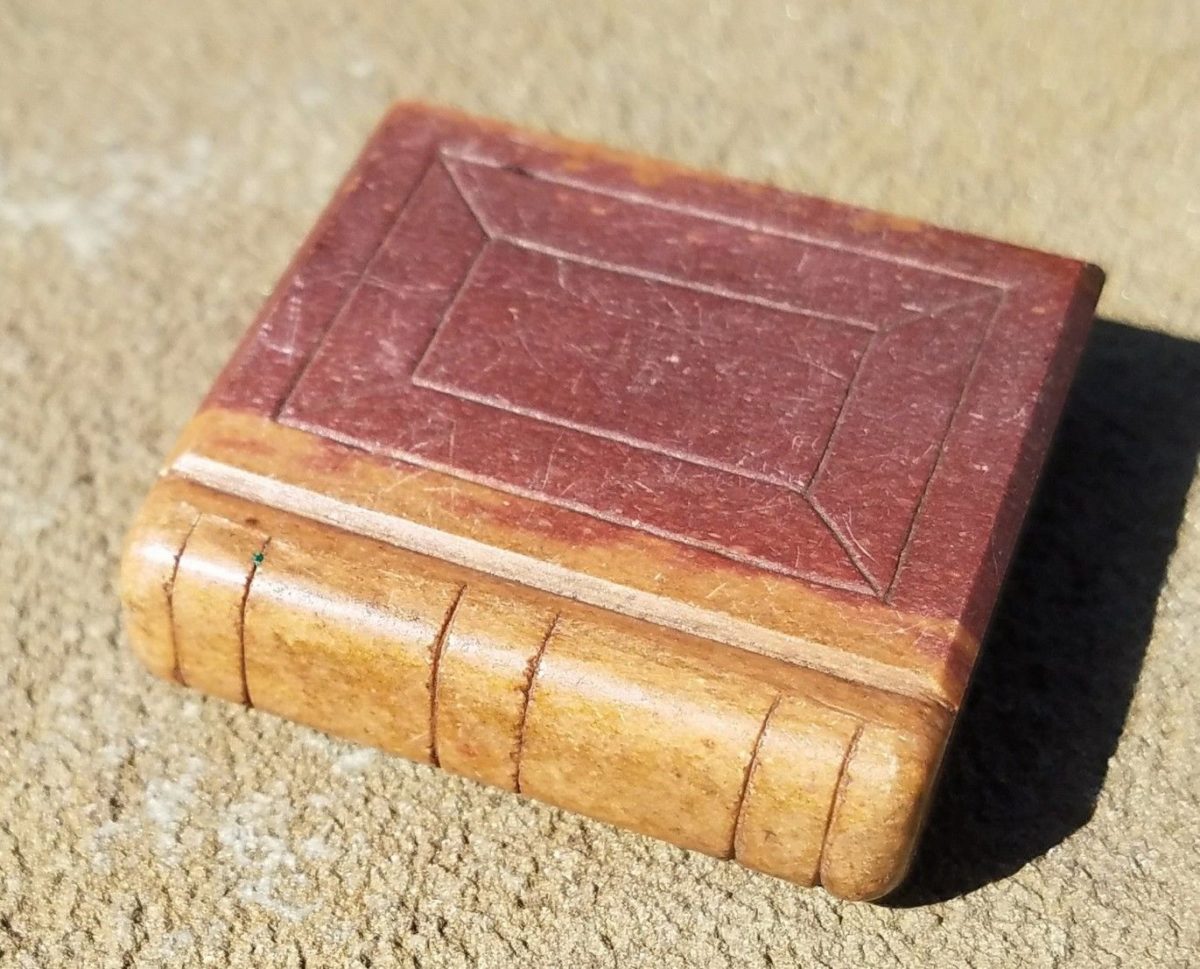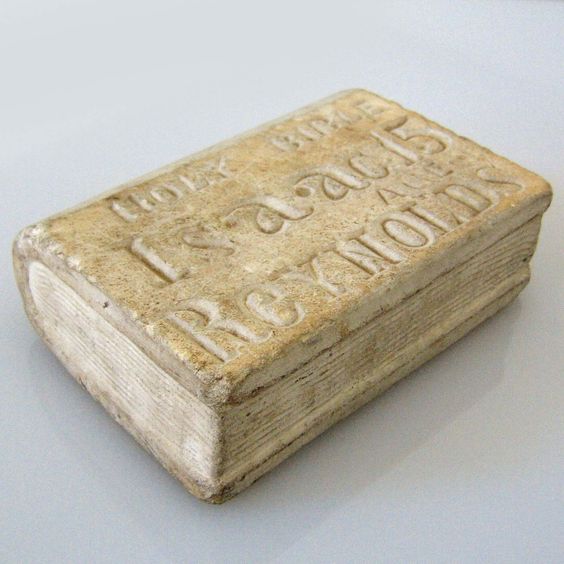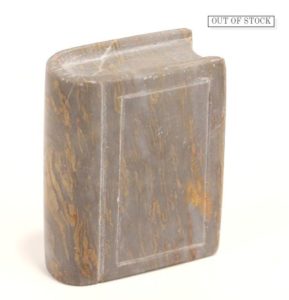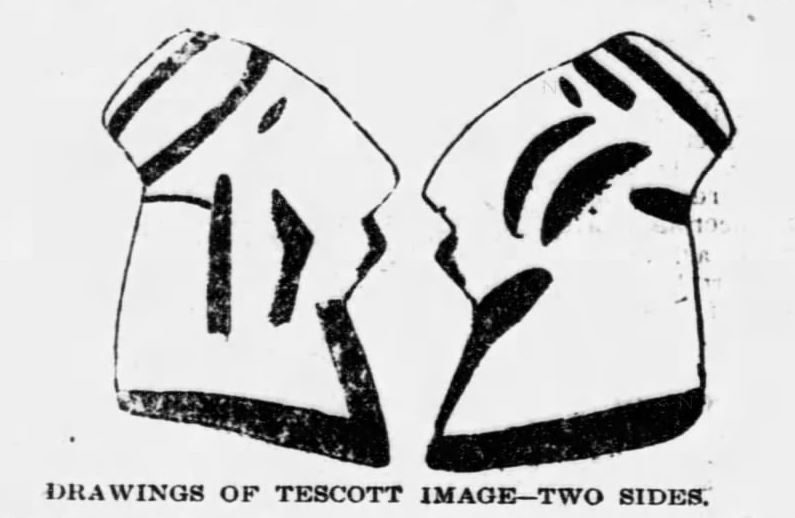The Little Stone Book

The Little Stone Book The ancient stone book discovered by a Kansas antiquary.
Once again, we turn to the wonderful world of anomalous artifacts with this story of
A STRANGE STONE BOOK FOUND IN KANSAS.
It Was Discovered Near Indian Mounds and is Made of Red Pipestone Clay.
George U.S. Hovey of White Church, Ks., has among his very interesting collection of stone relics a small stone book which he found near the three Indian mounds in Quindaro township, Wyandotte. Mr. Hovey has spent years in deciphering the stories of stones and flints that he has found in the neighborhood of Kansas City. He has the largest collection of relics of the stone age in the west. His home is full of them and the overflow is piled up in his yard. As the result of his investigations he has some new theories which he is trying to impress upon the scientists at Smithsonian and Peabody.
One of Mr. Hovey’s especial prizes is this little stone book. It is made from the red pipestone clay found in Minnesota, weathered some with age, making it darker than when first taken from the quarries. It is about three inches long, two inches wide and one inch thick. The lines are not as true as they would have been had the workmen had modern tools, but nevertheless it is a good representation of a book.
“Near the mounds where the book was found was the site of a prehistoric town,” said Mr. Hovey. “Here then dwelt for many years, with their wives and children, and here are to be found in great numbers their implements for the war and the chase. We know their workshops from the flint, chips, and spails. Thousands of arrowheads have been found, also many currying stone knives called by the Smithsonian professors ‘humpbacked knives,’ indicate that here were also located their tanneries. The extent of the ground, the many loads of flints removed since the place has been known to the whites all show that it was a town of considerable importance. The number of these ancient town sites and mounds within the limits of Wyandotte county makes it not a rash assertion to say that 1,000 years ago enough people lived here to make a great city. But to come to the stone book.
“There is a tradition that a great medicine man had a stone bible and this is the way it goes: The first whites to come among the Indians were missionaries. They talked, they preached, they prayed, and always from a book. Their works appeared good and they soon had great influence over the red man. The food and furs that had kept the wild medicine man from work and want now went to the preacher. The medicine man’s influence was gone and starvation was near. Something must be done.
“To him it appeared that all the power came from the book the missionary carried. He must, too, get a book, he said. He went to the far north and there he secretly made a book of stone. On his return he preached and he proved that the book that he preached from could stand the test of fire and water. In that respect it was better than the book of the white missionaries. He also told them wonderful things the book contained; about traders who would come and who would take their furs and exchange for firewater, making them all at times crazy fools; of men who would come with weapons of fire that made a great noise and would kill and scare away all the game. Then he told of many more white people who would come and how would want their land, then great troubles and quarrels and finally of white warriors who would kill and drive all the Indians away. He talked with so much earnestness and strength that soon he was reinstated, and to this day among most all tribes are the two factions, the blanket Indians and civilized, the pagan and Christians.
“There’s still another story. For years we have been taught that the richest land in the world is for a hundred miles or so around Kansas City. The Mormon bible teaches and told years ago that the Garden of Eden was located not far from here. Arrangements are being made to erect the Mormon temple at Independence. Some of the faithful think that the stone book is a new testament—a new revelation to the old Mormon bible—and when interpreted and read by the great prophetic head of the Latter Day Saints, looked at, into, and through by Urim and Thummin spectacles, it will read that the center of the Garden of Eden is where this book was placed and on that spot the great temple will be built. Not in Jackson county, Mo., but in Wyandotte county, Ks.”
Plain Dealer [Cleveland OH] 27 January 1901; p. 33
According to Kansapedia, the first Catholic missionaries arrived in the 1820s; the first Baptist missionaries in 1830. It is a pity that Mr. Hovey does not tell us if the stone book was found in or on the mounds or, if buried, at what depth.
I assumed “pipestone clay” was, well, clay and since I’d seen book-shaped pottery flasks, I also assumed that this piece was something on that order.

The Little Stone Book Bennington pottery book flask. The spine is marked “Departed Spirits.” https://www.skinnerinc.com/auctions/2858T/lots/1261
Pipestone clay actually refers to Catlinite, a fine-grained stone used by Native Americans to carve pipes and effigies. Carved stone books are a well-known motif in folk art, as in these examples:

The Little Stone Book 1870-90 folk art, small carved stone book. https://www.ebay.com/itm/1870-90-Folk-Art-Tiny-Stone-Book/323200725177?hash=item4b4043b0b9:g:9-4AAOSwCQxazAWl

The Little Stone Book, 1901 folk art carved stone book, signed and dated. Ebay listing

The Little Stone Book Miniature stone folk art book, c. 1900 from Vermont. Probably carved by a quarryman or gravestone carver. http://oldasadam.com/product/miniature-stone-book/
Mr. Hovey was well-known in Wyandotte County: he was a notary public, county commissioner, postmaster, merchant, and, most notably, an antiquarian. He also had a vivid imagination, useful in a writer of historical fiction, but perhaps less helpful when examining unusual artifacts. As the article mentions, he had an immense collection of artifacts and an equally large stock of theories about those artifacts.
Mr. Hovey had the knack for finding the unusual. Just a few months later, in March of 1901 he was again in the papers, speaking about another of his finds: a tiny stone head, which he felt proved contact between the Aztecs and the Native American tribes of Kansas. Much to my frustration, the source here is a California paper, which reprinted the Kansas City Journal article, but failed to print the illustration. Special place in hell….
Here again, we find some lyrical flights of fancy on the part of Mr. Hovey about a little stone artifact.
STRANGE STONE HEAD
Relic Found in Kansas Which Seems to Show intercourse Between Ancient Inhabitants and the Aztecs.
[Kansas City Journal] A tiny stone head in the collection of George U.S. Hovey of White Church, Wyandotte county, Kan., has given its owner a very fruitful subject for thought, and has also interested the wise men at the Smithsonian Institution, Washington, and the Peabody Museum, Boston.
This interesting little relic is about the same size as the picture of it which accompanies this article. It was carved from stone, and in color is of a light yellowish cast. Mr. Hovey picked it up near the great storehouse of antiquities around the three mounds of Wyandotte county, Kan.“It was found buried under the accumulation of soil some little distance,” said Mr. Hovey, “and must have been there for years, perhaps for centuries, before Europeans came to the country. That it was a well-executed piece of work is very clearly shown by an examination. It was the workmanship, no doubt, of one of the best artisans of the time. Does it represent the face of a man or woman? The big nose, that Napoleon liked in his generals, and the width between the eyes, seem to favor the sterner sex. Markings for the hair are not shown. If it was made from the face of a woman the model must have been an Amazon—perhaps the Mrs. [Carrie] Nation of her day. But still more important is the question, from what race did the ancient sculptor model the head? Was this model from the East or the West, from Egyptian or from Japanese? Answer that and you may have a key to the origin of the early inhabitants of this land.”
The back of the head is flat; and at the base are two projections with notches. This, Mr. Hovey thinks, indicates that the stone was to be fastened to a piece of wood. Other stones with projections that might have been made to represent a nose have been found in the neighborhood. “After making markings with ink to indicate eyes, mouth and ears, we have,” said Mr. Hovey, “a very creditable Brownie. Then dress it in fancy furs, trim with bright feathers and you have a toy that would set the tongue of any little one wagging and her eyes dancing with delight.
“But this particular head must have been much too important for a plaything of a child. It appears to me that it belonged to some great chief or high priest. It was fastened to a wand and from it radiated circles of feathers, and fringes of brilliantly-colored hair and bits of the finest fur. Brought to view at times of feast, victory or worship, its office was of great ceremonial importance.”
Mr. Hovey does not attempt to identify the race or the people by whom the relic was made. “We think,” he said, “that everything the former inhabitants of this land made was for a purpose and we try to think, too, that what they could do, they did. But scientists tell us that this little head was hardly made here. A scholar, who has spent some time in delving in the past, said that it was undoubtedly of southern manufacture; that he has seen similar heads on Aztec vases in the museum at the City of Mexico.” The Los Angeles [CA] Times 15 March 1901: p. 13
Brownies aside, what could be the explanation for the book carving? While other carved heads have been found in Kansas, such as a carved stone head “picked up on top of a hill in 1887 near Tescott, Ottawa county, by Mrs. Kate B. Spears…now in the collection of the Agricultural college at Manhattan.” [The Mail and Breeze [Topeka KS] 12 July 1901: p. 4] the book seems a unique artifact to find in a Native American context.

Did some prankster carve the book and plant it where Mr. Hovey would find it? Was it really a shaman’s magical object or just the discarded work of a quarryman? And were the book and the tiny head shipped to the Smithsonian and lost, in the time-honored Fortean manner, in the mail?
Well, no…. Mr. Hovey died in 1906. His daughter donated at least part of his collection to the University of Kansas at Lawrence.
K.U. GETS INDIAN RELICS.
The Collection of the Late George Hovey Given by His Daughter.
Lawrence, Kas., July 8. The museum at the university has received a fine collection of Indian relics. It was made by the late George U.S. Hovey of White Church, Wyandotte County. The gift to the university is that of his daughter, Miss Anna Hovey of Kansas City. More than two thousand bird and game points for arrows are in the collection made up of red, white and black chert, the black predominating. A great variety of tomahawks and axes. Among the ceremonials in the collection are a little stone book with which a very pretty tradition is connected, and an almost perfect piece of crude art in the form of a little stone head. These were all found near the mounds close to the boundary line between Kansas and Missouri, near what Mr. Hovey believed to be a prehistoric town.
Mr. Hovey spent many years in making the collection. He made an attempt to study the articles in view of finding some definite trace with regard to the history of the people who preceded the white man. He worked much with the Smithsonian Institute at Washington. He was commissioner of Wyandotte County for many years. Kansas City [MO] Star 8 July 1911: p. 4
But where are the artifacts now? They are not mentioned in the collections at the museums at the University of Kansas or the state historical society. Mr. Hovey sent some photos of his artifacts to the American Museum of Natural History in New York, so possibly the images languish in some file cabinet or digital archive.
Any ideas on where the little stone book is today? The answer is as a sealed book to me. chriswoodyard8 AT gmail.com
Floodmouse raises some interesting questions and cautions us not to discount the amateur archaeologists of the past. Thanks, Floodmouse!
Mr. Hovey said there was a “tradition” that a medicine man (or shaman) used the stone book to help him compete against the Christian missionaries who were stealing converts from his flock. I assume this was an oral tradition, and it would be interesting to know who was telling the story. Did Mr. Hovey have Native American informants who helped him dig for relics? Too bad he didn’t have anthropological training to record everything he heard in detail. It’s far from impossible that this story really happened the way he said – a shaman using a stone book as a prop or an object of power, adding it to his repertoire of sacred objects. Reminds me a bit of the “Ghost Dance” movement where shamans promised a way to become immune from bullets – traditional religion bending and adapting to foreign pressures. As far as the “Aztec” head, I wouldn’t be entirely surprised if grave goods included objects traded up from the south, though without seeing the original, who knows where it really came from. Presumably he recognized something that didn’t look like local craftsmanship. There’s a tendency to discount the opinions of these 19th century collectors, because after all they were wrong when they thought Native American Indians were descended from Egyptians or the lost tribes of Israel – but on the other hand, they weren’t complete idiots, and a lot of their local observations were perfectly valid, even if they drew incorrect conclusions. After all, archaeology was in its infancy and they were speculating based on very limited information, but I would pay close attention to their “direct” observations (what they saw and heard with their own eyes and ears).
Chris Woodyard is the author of The Victorian Book of the Dead, The Ghost Wore Black, The Headless Horror, The Face in the Window, and the 7-volume Haunted Ohio series. She is also the chronicler of the adventures of that amiable murderess Mrs Daffodil in A Spot of Bother: Four Macabre Tales. The books are available in paperback and for Kindle. Indexes and fact sheets for all of these books may be found by searching hauntedohiobooks.com. Join her on FB at Haunted Ohio by Chris Woodyard or The Victorian Book of the Dead. And visit her newest blog The Victorian Book of the Dead.
